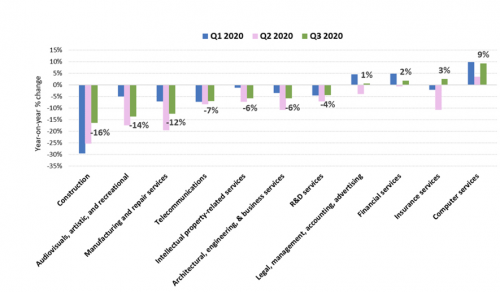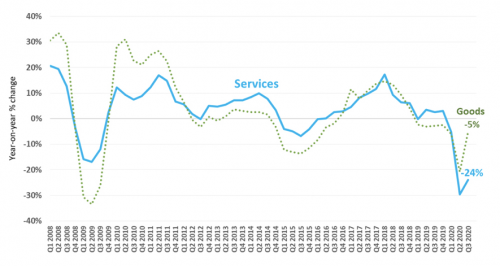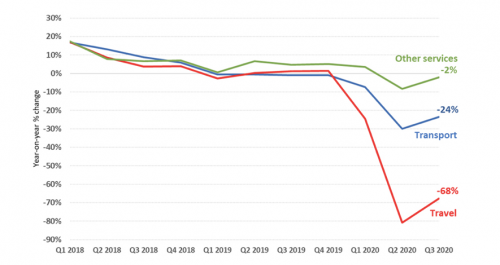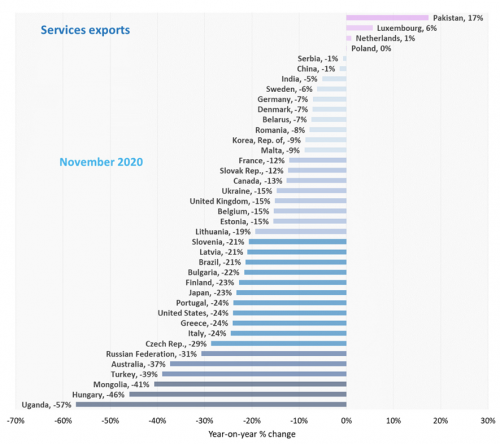OMC – Aún no se vislumbra una recuperación del comercio de servicios
Según datos estadísticos difundidos por la OMC el 26 de enero, el comercio mundial de servicios se contrajo un 24% durante el tercer trimestre de 2020, en comparación con el mismo período de 2019, lo que representa apenas un ligero repunte con respecto al descenso interanual del 30% registrado en el segundo trimestre, en acusado contraste con la recuperación experimentada por el comercio de mercancías, que fue mucho más contundente.
Preliminary data further suggest that, in November, services trade was still 16% below 2019 levels. Prospects for recovery remain poor since a second wave of COVID-19 infections necessitated new, stricter lockdown measures in many countries, with tightened restrictions on travel and related services extending into the first quarter of 2021.
The latest statistics confirm earlier expectations that services trade would be harder hit by the pandemic than goods trade, which was only down 5% year-on-year in the third quarter. Foregone expenditures on tradeable services could be directed elsewhere, with consumers shifting to goods instead.
Source: WTO-UNCTAD-ITC estimates.
Unlike goods, services cannot be stockpiled, which means that despite pent-up demand, many of the revenue losses from cancelled flights, holidays abroad, restaurant meals, and cultural/recreational activities are likely to be permanent. Travel remains the most affected service sector, down 68% globally compared with the same period of 2019. In the third quarter of 2020, spending by international travellers was down 88% in Latin America and the Caribbean, 80% in both Asia and Africa, 78% in North America, and 55% in Europe. The relaxation of travel restrictions in Europe during the summer months produced only a modest rebound in services trade in the third quarter.
Trade in “Other services”, such as construction, recreational, legal, and financial services, repeated its uneven performance: most sub-sectors contracted, with computer services a notable exception. With building projects delayed or postponed in many countries due to the pandemic, global construction exports were down 16% year-on-year, as several Asian exporters saw sharp drops. Audio-visual, artistic and recreational services also saw double-digit declines (-14%), with the United States’ exports down 24% and the United Kingdom’s cut nearly in half (-45%). Legal, management, accounting, and advertising services saw a tepid year-on-year rebound of 1%. Financial services increased by 2% globally, with exporters in different regions recording positive growth. This includes the European Union, whose financial services exports were up 4% year-on-year. Computer services remained the most dynamic sector in the third quarter, up 9% due to increasing global demand for cloud computing, platforms and virtual workplaces.

Source: WTO estimates based on WTO-UNCTAD-ITC data.
Preliminary estimates suggest that global services trade remained depressed through November, down 16% year-on-year, based on data from 39 economies accounting from more than two-thirds of world services trade. This marks a slight improvement from October, when services trade was down 18% compared to the previous year.
Services exports in November were down 24% in the United States, 15% in the United Kingdom (both on a seasonally-adjusted basis), and more than 20% in many European countries. Uganda, a country whose economy is highly dependent on tourism, saw services export revenues drop 57% compared to pre-pandemic levels. China’s services exports also slowed (-1%), mirroring its performance in October. Financial services and computer services respectively sustained Luxembourg’s and Pakistan’s export growth.
Source: National data and Eurostat.
Early figures indicate goods rebound continues.
Preliminary figures, on a customs basis, from 72 countries accounting for 92% of global merchandise trade suggest that the rebound that started in the second half of the year picked up strength in October and November. The value of global merchandise trade in October 2020 was 3% higher than in October 2019, with a 6% increase year-on-year for the month of November.
These figures partly reflect purchases that were deferred earlier in the year, as well as weakening trade growth in the closing months of 2019 due to heightened trade tensions at the time. There is considerable variation across regions in the pace of expansion. Asia and Europe saw their exports increase in November by 10% and 6% respectively. However, exports were still down 5% in North America and 2% in Latin America and the Caribbean. The recovery remains incomplete: the total value of global merchandise trade between January and November 2020 was 8% below the same period in 2019.
OMC






















